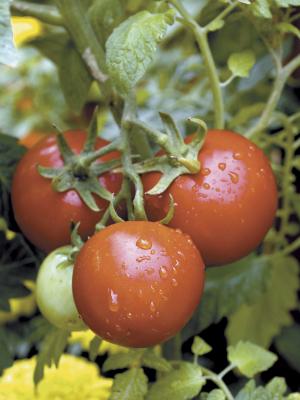Save and grow out your own strain of tomato
When it comes to heirloom tomatoes, the Brandywine stands alone. This is a prolific plant that produces huge one- to two- pound pink fruit. The Brandywine tomato plant is unusual because it has potato leaves, where the leaves are smooth and oval with a pointy tip. But it is the flavor of the Brandywine tomato that has made it famous. It has a deep, rich, intense tomato flavor.
Alas, just as all siblings are not the same, not all Brandywine tomatoes are alike. The most famous Brandywine, and possibly the original, is from a woman named Dorris Sudduth Hill of Murfreesboro,Tenn., whose family grew them since the 1800s.
Mr. Ben T. Quisenberry ran a small mail-order seed company called Big Tomato Gardens out of a former post office in his hometown of Syracuse, Ohio. Ben printed his own seed packets on a vintage printing press. He specialized in saving heirloom tomato varieties from extinction. In 1982 he introduced the “Sudduth strain” of Brandywine into the Seed Savers Exchange. From there it went viral. Some sources say that the Brandywine tomato is of Amish origin, but nothing backs up that claim. They grew the huge, lumpy, pink tomatoes, saving the seeds because of the deep, true tomato flavor.
If you have a special tomato variety and want to make it even better, you can begin saving your own seed and create your own heirloom tomato. By selecting tomatoes that do well in your garden you will be saving the genetic material to reproduce those good results year after year. Tomatoes are among the easiest vegetables to work with in developing your own strain, or landrace.
A landrace is a local variety of a domesticated plant species which develops mainly by natural selection to adapt to a local garden environment. A landrace is different from a formal breed, because a breed is purposely selected to fit particular formal, purebreed standard of traits. Landraces are more diverse genetically and physically than formal breeds.
You don’t’ need many tomato plants as parents to maintain their genetic diversity. Ideally use 30 tomato plants as parents, as opposed to about 1,000 for corn. Tomatoes are usually self pollinating, so you need only a short isolation distance of 35 to 40 feet between varieties for pure seed.
To begin your own strain of tomato, carefully choose the parents. Remove any plants that haven’t’ flourished in your garden.
Choose tomatoes that are dead ripe. Slice the tomato in half between the stem and blossom ends. Tomato seeds are found in the cavities of tomatoes surrounded by gel. Scoop the seeds and gel out of the cavities. Pour the seeds, gel and all, into a jar or cup. Add enough water to cover the seeds. Place your jar of seeds in a warm location, such as the top of the refrigerator for a few days. Your seed and water mixture will begin to ferment in a day or two. A scum will form on the surface. This fermentation destroys seed-borne diseases.
After two or three days, gently rinse the seeds in running water until only the seeds remain. Spread the seeds out on a smooth board or ceramic plate; they can stick to paper plates or cardboard. Let the seeds air dry out of direct sunlight. Stir them around daily so they don’t stick together or stick to the plate or board. When your seeds are thoroughly dry, store them in an airtight jar out of direct sunlight. Your homemade tomato seeds are viable for five years or longer.
Every year, save seeds from only the best tomatoes. By repeating this process year after year your tomato will slowly evolve into your very own strain.
In addition to the Sudduth strain of Brandywine tomatoes, you might find Platfoot strain from Gary Platfoot of Ohio or OTV strain of Brandywine from Off The Vine seed growers. Once you select, save and grow out your own strain of tomato, you can now do what gardeners have been doing since time immemorial, share your seeds. After all, even Dorris Sudduth Hill got her first seeds from someone else.























































